 BioCycle July 2009, Vol. 50, No. 7, p. 25
BioCycle July 2009, Vol. 50, No. 7, p. 25
The market for compostable products is expanding, due in part to a growing composting infrastructure. Part I
Rhodes Yepsen
SINCE BioCycle‘s Compostable Products Update two years ago, dozens of new manufacturers have come onto the scene, joining companies who have been expanding their product lines and production volumes. In North America, the Biodegradable Products Institute (BPI) remains the focal point for tracking the action, with its vetted logo designating products that meet ASTM (American Society for Testing and Materials) requirements for compostability. “The shear growth in number of BPI program participants not only shows the breadth of the compostable products industry, it also correlates to overall growth within the area of organics diversion,” says Steven Mojo, Executive Director of BPI. “For instance, findacomposter.com, BioCycle‘s free searchable database, mirrors this trend of growth in compostable products, with more facilities popping up across the U.S. and Canada.”
With major companies like Solo Cup, Coca-Cola, Wal-Mart (in Canada), Whole Foods, International Paper, Glad and Dixie Cup offering branded compostable products, there is overwhelming evidence that this marketplace has gone mainstream. Manufacturers, consumers and composters are also paying more attention to whether the products are actually compostable, seeking out the BPI logo. “The composting industry increasingly understands that BPI-approved products will compost appropriately, and that products with faulty claims stand out on the screens at the end,” says Mojo. “This is coupled with legislation in California and Minnesota allowing ASTM D6400 compliant compostable bags in municipal programs instead of ordinary plastic bags. And a number of major retailers like Wal-Mart and Shopper’s Drug Mart in Canada and Whole Foods are utilizing BPI-approved compostable products for their store brand, showing that a broader range of customers are paying attention.”
BPI’s website (bpiworld.org) currently features 25 bag manufacturers, 27 companies making foodservice items and packaging films, and 19 resin manufacturers. To put this in perspective, BioCycle’s July 2007 article on compostable products reported 12 bag manufacturers and 12 companies making foodservice products and film.
BioCycle contacted all of the companies making BPI certified compostable bags and foodservice products, and a handful of the resin manufacturers to obtain information for this article. Those who responded to our inquiry discussed new products, the expansion of the composting infrastructure, customer concerns about price, the importance of education, public confusion over biodegradable vs. compostable, and recent legislation. Part I of this article is an industry profile of North American compostable products, based on those responses. Part II will discuss how compostable products fit into models of sustainable packaging and Extended Producer Responsibility (EPR), and will include detailed interviews with resin manufacturers and international compostable product companies. All products described in Part 1 as compostable are BPI certified, unless otherwise noted.

NEW PRODUCTS
“At the National Restaurant Association Show this year, nine organizations in foodservice were showcasing new products using Ingeo™, our brand of PLA [polylactic acid],” says Brian Glasbrenner, Americas Business Director for NatureWorks, a company owned by Cargill. “This included innovations for the industry, such as the EcoProducts compostable hot cup lid and International Paper’s ecotainer cold cup, as well as new brands like the Dixie Cup from Georgia Pacific and products with a design emphasis, such as Innoware’s two-color clamshell packaging.”
When International Paper (IP) launched its ecotainer cold cup, it simultaneously announced that it had sold over one billion ecotainer hot cups and containers since the brand’s market entry. “The one billionth ecotainer is a milestone for the compostable products industry, and shows the type of reliability that IP brings to the marketplace,” says Bruce Thoman, Director of Foodservice Product Development at IP. “Only after developing the ecotainer hot cup did we move on to the cold cup. Ingeo PLA seals, forms and flows differently than the polyethylene we’ve used for years, and there’s no textbook on how to use it, so there has been a huge learning curve for adapting our equipment and methods. The ecotainer cold cup was challenging because it’s a paper cup with PLA lining on both the inside and outside, for condensation. We also had to develop technology for printing on this surface, which in itself took almost a year to figure out.”
The ecotainer cold cup was introduced in partnership with Coca-Cola as part of a pilot project at the University of Washington in Seattle. Coke is now working to roll out the cup nationally. “The largest portion of the waste stream at foodservice establishments is organic, totaling 70 percent or more, and we’re looking at how to support our customers in managing that waste responsibly,” says April Crow, Global Sustainable Packaging Manager for the Coca-Cola Company. “Previously, there were limitations with performance for compostable products, but now there are more solutions in the marketplace. We provided a compostable clear cup for the 2002 Winter Olympics in Salt Lake City, and now we have the ecotainer cold cup – paper cups are the predominant cup in the foodservice industry, so this is a huge step forward.”
Asean, a newcomer to BPI, manufactures compostable products under three brands, and does private label products as well. Its Stalkmarket brand offers cups, plates, bowls and takeout containers made from sugarcane bagasse, using preconsumer waste. “A growing number of national retailers are carrying this product line under a private label program,” says Buzz Chandler, President of Asean.
Asean’s Jaya brand offers cutlery, clear cups and straws. “Our products change as new technologies and resin grades are developed,” explains Chandler. “For instance, we announced new fully compostable Ingeo cutlery at the National Restaurant Association Show this spring, which is actually made using waste material from our new compostable hot cup lid. The PLA cutlery is heat resistant and compostable, and replaces our previous plant starch material (PSM) cutlery.”
EcoProducts is not a new company, but has become more prominent in the last few years, manufacturing its own brand of compostable products. “We were founded in 1990 to distribute recycled office products, eventually branching into other green items, and in 2005 we offered our first branded product, a green-striped compostable cold cup,” says Luke Vernon, Chief Operating Officer of EcoProducts. “Eventually we phased out selling our competitors’ products. Most recently we introduced a compostable hot cup lid, completing our cup and sleeve offering.”

Nature Friendly Products now carries over 200 compostable items, including IP’s ecotainer cup, and its own line of sugarcane plates, bowls, cups, trays and take-out containers, which are currently going through BPI certification. “Everywhere that there are disposable foodservice products, customers are looking for green alternatives and finding compostable solutions,” says Bill Biggar, Managing Partner for Nature Friendly Products. “This is the first time that we have several factors in play at the same time: a strong awareness and demand for compostable products, the composting infrastructure is coming into place, and there’s an economic value for diverting organic waste. Now that these segments are lined up, things are taking off!”
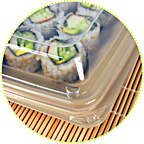
Innoware manufactures compostable takeout containers under the brand Eco—Return to Nature™, which have traditionally been two-piece containers. “One of our newest innovations is a hinged Octaview® clamshell that is coextruded with two colors,” says Hanna Sjolund of Innoware, Inc. “It has a crystal clear lid, which contrasts with the tan base, highlighting the food inside. Our containers also convey an upscale image – we have been most successful in restaurant segments willing to pay a slight premium for a product with a clean and attractive design. The color scheme offers a visual clue to the consumer that the product is earth friendly, and makes it easily identifiable for the composting facility.”
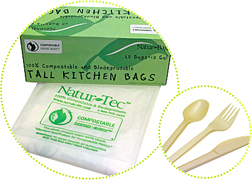
Northern Technologies, which manufactures Natur-Tec compostable bags, has expanded its product line to include items such as cutlery, films and foam for packaging. “We have been doing a lot of product development over the past two years, taking a base technology and targeting new segments,” says Vineet Dalal, Vice-President & Director of Global Market Development, Northern Technologies International Corporation. “We have been looking to continually increase the biocontent in our products, and are working with some large consumer goods companies to incorporate our film into their packaging, such as for chocolates and candies. However, these applications require a lot of R&D to meet specific properties for shelf life, etc., and take a while to commercialize.”
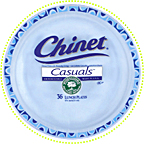
As compostable products become more mainstream, companies are changing marketing and advertising strategies to showcase this end-of-life benefit. Chinet, for instance, updated its retail packaging and logo early this year, essentially taking information from the back of the package and highlighting it on the front. “We’re strengthening our communication about the environmental benefits of Chinet products, but the products themselves have not changed – they were already compostable, and had been BPI-certified within our commercial food service division,” says Eric Happell, Director of Huhtamaki’s U.S. Retail Business for fiber products. “Chinet paper plates have been made in the U.S. since the 1930s. We switched to 100 percent recycled content in the 1970s, because it was more efficient, less expensive, and ultimately it was more environmentally friendly. We use by-product preconsumer paper from the milk carton and frozen food industries.”
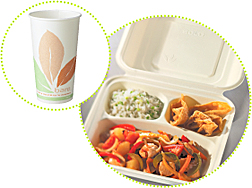
Solo Cup entered the compostable products industry, marketed under its Bare™ by Solo® brand. “The Bare product line was launched in the spring of 2008, with a number of new products added to both the retail and commercial offerings in 2009,” says Angie Gorman, Director of Communications for Solo Cup Company. “We introduced a PLA-coated paper hot cup in the fall of 2008 using Ingeo, and have since expanded our compostable offerings with compostable sugarcane plates and bowls, and an oatmeal-colored modified PLA cold cup and treated wax cold cups.”
The Bare product line is not all compostable however, including foodservice ware that is made from renewable and recycled content such as recycled PET (RPET) cups and post-consumer fiber hot cups. “It’s very clear to us that sustainability is a lifestyle choice that more people are making, and a trend we need to be a part of,” explains Gorman. “We have compostable products as well as options made from renewable materials and recycled content materials because we believe options are important to our customers. For communities across the country that don’t have composting facilities, recycling is still the best option.”
BAGS AND BEYOND
Compostable bags are still the backbone of many municipal organics collection programs, helping residents deal with potentially messy food scraps in their kitchen, while reducing problematic plastic film at composting facilities. Several companies specialize in manufacturing compostable bags, which are finding new consumer uses.
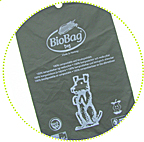
BioBag USA now offers about 25 different bags, as well as agricultural film called BioAgri. “We’ve found that cart manufacturers are like car dealers, constantly changing designs, so we offer a wide range of sizes,” says Dave Williams, President of BIOgroup USA, Inc., which makes the BioBag. “Doggie bags, which we introduced in 2002 for cities to purchase for their dog parks, have become very popular. They are now available in retail packages at major outlets like Petco.”
BioBag recently introduced compostable produce bags on a roll for use in supermarkets, which offer additional benefits over their conventional counterparts. “Customers take produce home and store it in their refrigerators, and due to Novamont’s Mater-Bi resin, our bag breathes,” says Williams. “Once the produce is eaten, the bag can be reused for collecting compostable waste.”
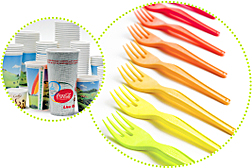
Another application where compostable bags are being used for a dual purpose is at King County (Washington) Library. “The Library system purchased 350,000 of our new T-shirt style compostable bags, introduced this year, which people can use to carry checked out books home,” says Steve Friese of Indaco Manufacturing USA, which makes Bag-To-Nature brand compostable bags. “The bag will then have a second use in the kitchen, collecting food scraps for King County’s residential organics program.”
Cortec introduced several new films, including a compostable film that is 45 percent renewable content, and updated its existing films. “We are moving ‘beyond the bag,’ so to speak, in relation to our R&D,” says Bob Boyle, Global Account Director of Cortec Corporation. “For instance, Bio-Cushion™ is an inflatable void filling system for shipping and packaging, using compostable film. Also, a lot of our new requests are coming from food service and hospitality, driven by company directives rather than municipalities.”
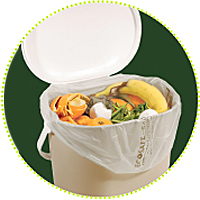
Plastics Solutions now offers a kitchen collector, along with an appropriately sized EcoSafe compostable liner. “This provides an easy way for households to start collecting food scraps, with a tidy package,” says Dick Freeman of Plastics Solutions, Inc.
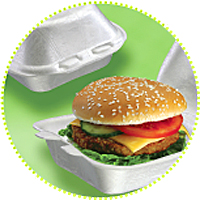
El-En Packaging introduced a BPI certified compostable bag last summer with the brand name Quikki, using BASF Ecoflex. “We’ve been manufacturing garbage bags for 40 years, and began researching a compostable bag due to customer requests and market demand,” says Cheryl Babcock of El-En Packaging Company, Ltd. “In Canada, the compostable bag industry is driven purely by municipal organic programs, and there has been steady growth over the past five years. Legislation is important, because when compostable bags are optional, consumers are less inclined to use them, due to the added cost.”
Farnell Packaging also uses Ecoflex resin for its lines of compostable bags, marketed under the brand names BioTrue and Big Boy. “Consumer demand for compostable bags and packaging is up, whether seen at zero waste events or with customers introducing new lines of compostable packaging,” says David Stanfield, Vice-President of Sales and Marketing for Farnell Packaging Ltd. “We are continuously improving our compostable film products, and are now selling to a larger market – what was once primarily municipalities now involves hospitals, schools, consumer product companies, etc.”
24/7 EDUCATION MODE
Education is an important facet of all organics diversion programs, to ensure that participants know what is compostable and how to properly sort. “BPI works with communities on educational materials for residents, such as signs and brochures typically put together when launching a new organics program, or expanding it to include compostable products,” says Mojo of BPI.
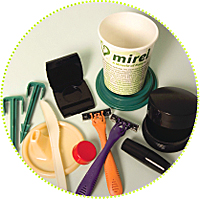
“Even though awareness has increased, we’re still not at the level seen in Europe,” says Bob Findlen, Vice-President of Sales and Marketing for Telles, which manufactures Mirel, a compostable resin, through a joint partnership between Metabolix and Archer Daniels Midland. “Those who know about composting understand the importance of diverting waste from landfills, and all of the benefits, but most people in the U.S. still don’t understand composting. We still spend a lot of time on education and awareness about composting, biodegradation, and options for waste diversion, setting the bar before we can talk about Mirel.”
Vernon of EcoProducts agrees: “Unfortunately, a lot of people don’t know what compostabilty is. They get that there is a better solution than traditionally used materials, but we are still on education mode all of the time.”
Many companies are actively engaged with educating the public. For instance, Plastics Solutions offers a free Source Separation Management Booklet. “When a company or jurisdiction needs help with waste audits, we link them with our network of professionals, and when they are trying to set up a successful diversion program, we offer the booklet,” says Freeman of Plastics Solutions.
“We are constantly going to trade shows and visiting cities that are interested in setting up diversion programs,” says Williams of BioBag. “People want to learn about what is happening in other cities, and call us to hear about how our compostable bag fits into that process. There are plenty of success stories finally, with Seattle, San Francisco, Alameda County (California), etc. – now we know that residents will participate and the programs will work, so we need to get more cities up to speed, with more composting facilities operating.”
Adds Gorman of Solo Cup: “When customers ask us about our compostable products, we ask why they are interested in that option, and if they understand the disposal options in the community where the products will be used. Because the composting infrastructure is fairly limited in many parts of the country, we want to make sure our customers get the benefit they are after.”
Education of composting facility managers is also an important facet. Although many compostable products are easily identifiable, some are identical to their conventional plastic counterparts, and are viewed as contamination by the composter. “The issue of identifying compostable film products versus conventional plastic film is a major problem for many composting facilities, and thus their jurisdictions,” says Stanfield of Farnell. “The route some have taken is to say no to all film bags, due to issues with processing a mixed stream of waste. We’ve been producing compostable films since the early 1990s, and it is an ongoing education.”
BIODEGRADABLE VS. COMPOSTABLE
Although many new companies offering compostable products are following the rules by going through with ASTM approval and BPI certification, some are falsely marketing their products. This often comes in the form of calling a product biodegradable without specifying where or how it will degrade. In early June, the Federal Trade Commission (FTC) announced action against Kmart, Tender and Dyna-E for some of their paper products marketed as biodegradable.
According to a FTC press release, the agency charged the retailers “with making deceptive and unsubstantiated biodegradability claims… Since 1992, the FTC’s ‘Green Guides’ have advised marketers that unqualified biodegradable claims are acceptable only if they have scientific evidence that their product will completely decompose within a reasonably short period of time under customary methods of disposal.” It explains that the defendants’ products are usually disposed of in landfills, incinerators or recycling facilities, where it is impossible for them to biodegrade within a “reasonably short time.”
Added Michael Davis, an attorney with the FTC’s Bureau of Consumer Protection, in an interview with the New York Times’ Green, Inc. blog, “We hope that these actions will serve as notice to these markets that an unqualified claim of biodegradability is probably false and cannot be substantiated … Maybe a piece of produce could be labeled biodegradable if it’s customarily disposed of through composting, but the statistics show that most household trash goes to landfills.”
Williams of BioBag thinks that the FTC action is necessary, and will be beneficial. “Everyone is calling their products biodegradable, even when they are plastic garbage bags,” he says. “I think we are at the point where we need to avoid the word biodegradable all together, because it’s misleading to consumers and problematic for composters.”
Chandler of Asean agrees. “We need more publicity about how biodegradability alone doesn’t mean anything. Composters and suppliers of compostable products need to explain that when something goes to a landfill, it’s being sealed in a mummy’s tomb where nothing goes away.”
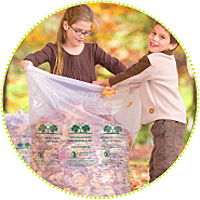
Notes Vernon Allen of Al-Pac, which makes compostable bags: “The biggest weakness for this industry is the general public’s misunderstanding of the differences between biodegradable and compostable. When customers ask us, as manufacturers of compostable products, they assume we have a hidden agenda. Clearing up this misunderstanding would lend a lot of credibility to the industry.”
PLASTIC BAG BANS
In May, the Governor of Minnesota signed a bill into law that bans use of conventional plastic bags for curbside collection of organic waste in the Twin Cities area, and requires compostable bags to be certified by ASTM (see sidebar). Residents have the option of using paper bags or removing their plastic bags after dumping their yard waste.
“Mandating the use of compostable bags for organics collection will not only ensure higher quality compost, by eliminating plastic contamination, but it will raise public awareness of what composting means and how compostable products can be used as effective tools,” says Dalal of Northern Technologies, who worked with Minnesota Representative Paul Gardener on the bill.
In Canada, local government mandates appear to be driving use of compostable bags. “Most of the demand we see in Canada has come from areas where it is mandated by municipal initiatives,” says Devin Sidhu of Alte-Rego Corporation, which manufactures bags under the brand Compost-A-Bag.
These plastic bag bans are a step in the right direction, but they occasionally create kinks that need to be ironed out. “Although the plastic bag ordinance in Minnesota was just signed by the governor, and won’t go into effect until January 2010, some local haulers stopped accepting conventional plastic bags on their collection routes already, to prepare their residential customers,” says Friese of Indaco. “However, the haulers are charging $2.50/bag for curbside debagging, despite the fact that Bag-To-Nature compostable bags cost about 80 cents/bag, and are available all across the Twin Cities area.”
When plastic bag bans are already in effect, it can be difficult to work a compostable option into the program. “We try to get involved with municipalities looking to introduce compostable bags as part of curbside food waste and yard trimmings collection,” says Williams of BioBag. “Sometimes the municipalities’ contracts with haulers already ban plastic bags, specifying paper or no bag. By adding the option of a compostable plastic bag, the contract may be opened up to rate increases, which then skews the original economics of the program.”
Other legislation impacting compostable products includes styrofoam bans, and San Francisco’s groundbreaking mandatory source separation of residential food waste and recyclables. These aspects will be addressed in the second installment of this article.
LACK OF INFRASTRUCTURE
Lack of composting infrastructure is consistently listed as one of the main barriers to widespread adoption of compostable products – if there is no place to compost them, the products don’t fulfill their full purpose and value. “Although there are pockets across the country with composting infrastructure to handle food waste and compostable products, it is not widespread, and this definitely limits which communities can use compostable products as part of their zero waste solutions,” says Dalal of Northern Technologies. “We’ll see broader adoption of compostable products in the marketplace as more facilities open to process them.”
To advance this, Dalal works with composting sites to see if they are willing to partner with food waste generators on diversion initiatives. “It’s a solution-at-a-time type of approach, and it’s a lot of hard work,” he says. “This is another place where legislation could really help, with government encouragement for diversion of organic wastes from landfills. Although there is a federal BioPreferred program through the USDA, it is focused more on using renewable resources, with compostability as secondary. An additional requirement of compostability would put more weight behind this movement.”
Some companies choose to highlight the front-end benefits of their products. “You have to be ready to answer customers’ questions about composting infrastructure, because 90 percent of the time the products are not going to get diverted,” says Vernon of EcoProducts. “Although our selling strategy is first about end-of-life, we also have a campaign detailing other benefits about our biobased content. For instance, studies have shown that Ingeo PLA takes less energy and produces less emissions to produce, compared to petroleum, meaning PLA products have a smaller environmental footprint.”
Canada is similar to the U.S., with composting infrastructure only in concentrated areas. “In western Canada, organics diversion programs just don’t exist – all garbage is created equal there,” says Babcock of El-En Packaging. “Atlantic Canada is the biggest driving force right now for municipal programs.”
When curbside collection is not an option, there are other means of closing the loop with compostable products. For instance, Sunfare, located in both Los Angeles and Phoenix, provides home delivery diet meal solutions, packaged in Innoware’s compostable takeout containers. “The meals arrive in our Expressions® line, which is a two piece container, because the caterer wanted customers to have a plate-like experience,” says Sjolund of Innoware. “The containers and leftovers are collected when the next day’s meals are delivered, and hauled to a composting facility.”
Another solution to lack of curbside organics collection is on-site composting, whether with an in-vessel system at a corporate cafeteria, or in the backyard at a residential home. These on-site composting systems are another possible avenue for handling the growing number of compostable products.
At the National Restaurant Association show this spring, Somat Company was awarded a 2009 Kitchen Innovations Award for its eCorect Waste Reducer, a commercial unit that dehydrates food waste into a soil amendment-like material (see “A New Generation Of Commercial Disposers,” BioCycle July 2008). “The eCorrect demonstrated to everyone at the show how a commercial food establishment can solve the problem of a municipality not offering food waste pickup,” says Chandler of Asean. “At least on the surface, machines like this seem to be a great solution to the infrastructure issue, and should be able to quickly process molded pulp compostable products, such as those made from sugarcane.”
Home composting may be the most viable option for some compostable products. “We conducted research trials about composting Chinet in backyard bins, and provide step-by-step guidance on our website for composting our products at home,” says Happell of Chinet.
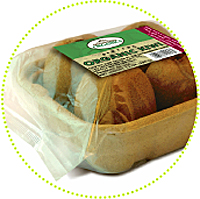
To Shanon Boase, founder of EarthCycle Packaging, composting infrastructure is not seen as a limiting factor. “Our product is also home compostable, along with the film made by Innovia, so it doesn’t rely on a municipal composting system,” she says. “EarthCycle products can also be recycled in a paper stream. We advocate the compostability of our product because we support upcycling – the products are made from waste palm fiber, after harvesting the oil, and if composted they are upcycled again by contributing to healthy soil.”
Earthcycle packaging can be found in the fresh produce sections of several large retailers, including Wal-Mart, Whole Foods, Wegmans, Trader Joes and Publix. Boase says the main limiting factor for her company is supply and production capacity. “We’re competing with the plastics industry, which has been around for 50 years, so we’re running to keep up. We are expanding our existing facility and building new ones to increase production and service demand.”
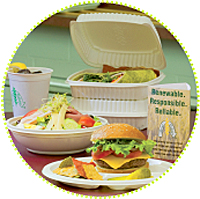
Several companies listed the extra cost for compostable products as a more significant barrier than lack of composting capacity. “In my opinion, cost is the biggest factor hampering the growth of compostable products,” says Jeff Cole, Marketing Manager for Genpak, LLC, which sells compostable products under its Harvest Collection brand. “Especially in today’s economic environment, operators are skittish about converting to products that may cost them upwards of three times as much as their conventional foodservice items.” That said, Cole still notes that the trend towards compostable products is high. “This is evident from customer comments at shows, and the click through rate to our Harvest Collection page of our website, which currently commands the second highest traffic rate behind our home page.”
Sidebar, page 30
MINNESOTA COMPOSTABLE BAG LAW
MINNESOTA bolstered its ban on landfilling yard trimmings recently when the Governor signed into law a bill that forbids the use of conventional plastic bags for yard trimmings collection in the Twin Cities area. It also requires compostable bags to meet ASTM D6400 or be certified by an independent organization. We asked Representative Paul Gardner from the Minnesota, who introduced the bill, for some more details.
Q: Why did you propose the bill and spearhead this initiative?
A: In the Twin Cities metro area, we have various requirements by counties and waste haulers on the use of bags. We have a lot of subscription hauling in Minnesota, so a hauler who wants to require its customers to use a compostable bag can be undercut by a competitor who will take the plastic bags. A city-by-city or county-by-county approach hasn’t really worked to clean out plastic from the yard waste stream, so using legislation to require the use of compostable bags instead of a plastic bag was the most effective way to clean up our compost stream, lower costs for haulers and their customers (haulers pay a higher tip fee when they haul regular plastic bags), and add value to our organic waste.
Many haulers have switched to rolling carts for yard waste, whereas other waste generators use kraft paper bags. Both are fine under the legislation, as is the use of plastic bags to contain yard trimmings being taken to a drop-off site as long as you take the bag with you after emptying it. As luck would have it, we have at least three manufacturers of compostable film in Minnesota, and they were very helpful in explaining the merits of the bill to legislators.
Q: When does the law actually take effect?
A: The bill passed and is now law. It kicks in starting January 1, 2010.
Q: Will residents/businesses be fined for using conventional bags for yard waste? Or how will it be enforced?
A: There is no penalty for generators. But during the summer and fall, the Minnesota Pollution Control Agency and the haulers will be working together on an educational strategy to make sure metro area residents know what the requirements will be. However, part of this strategy will likely be that yard trimmings enclosed in plastic bags won’t get picked up. My hauler will pick it up but they will charge you a debagging fee for the driver to cut the bag and empty its contents.
There is a civil penalty for manufacturers, distributors, and wholesalers who sell “biodegradable” bags in Minnesota that do not meet an ASTM standard for compostability. We will be working with retailers so that they understand the difference between compostable ASTM 6400 bags and the substandard “biodegradable” or “oxo-degradable” bags before 2010.
Q: What are some of the community benefits of this initiative?
A: It is likely that sales of the compostable bags will go up and create some competition that leads to lower bag prices. The environmental and economic benefits are that we will have higher quality compost, which will result in higher demand, which will result in higher finished compost prices and a demand for more organic feedstock. That will make it easier for communities to start up new source separated organics collection programs in the Twin Cities.
July 21, 2009 | General










